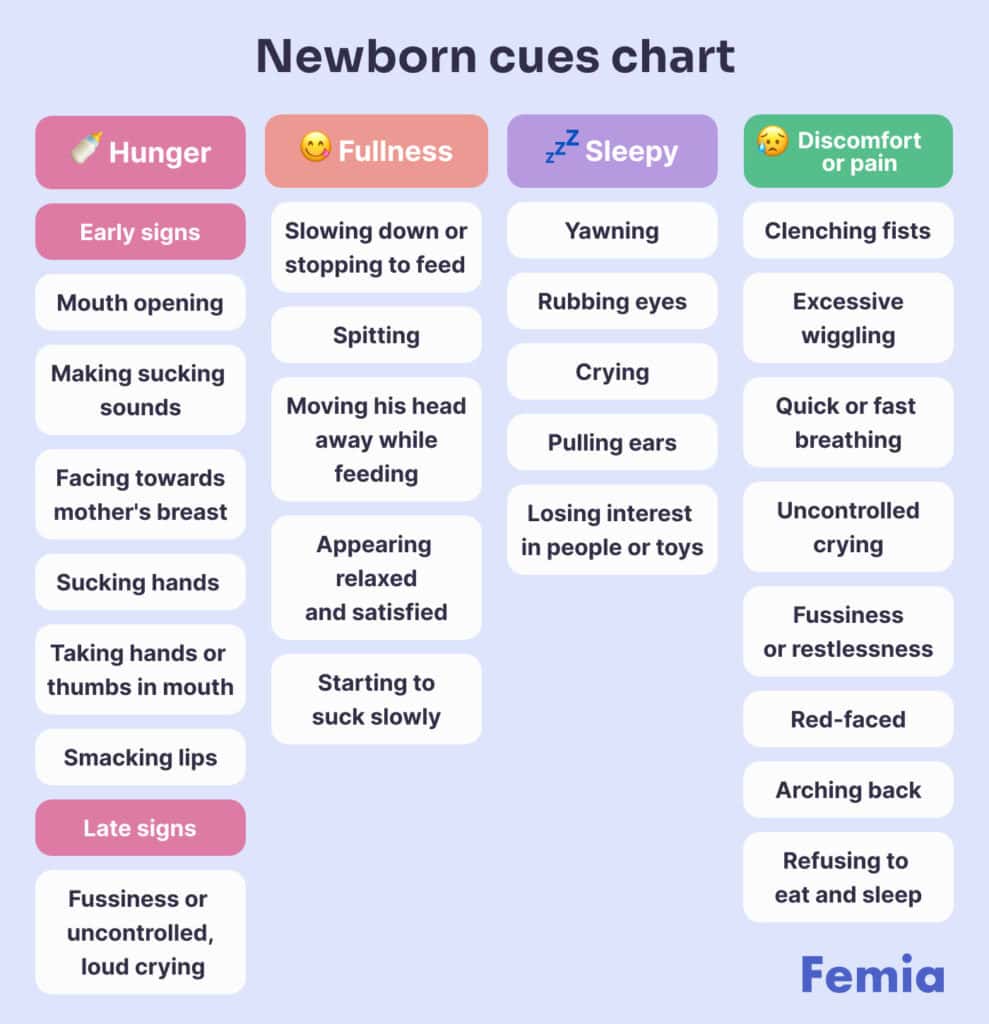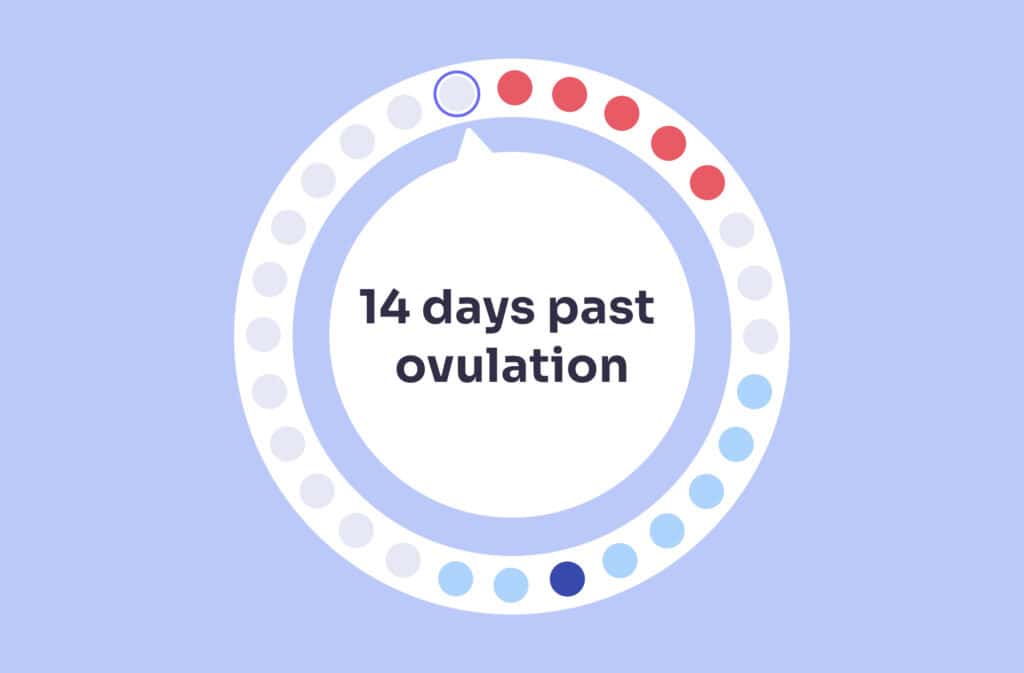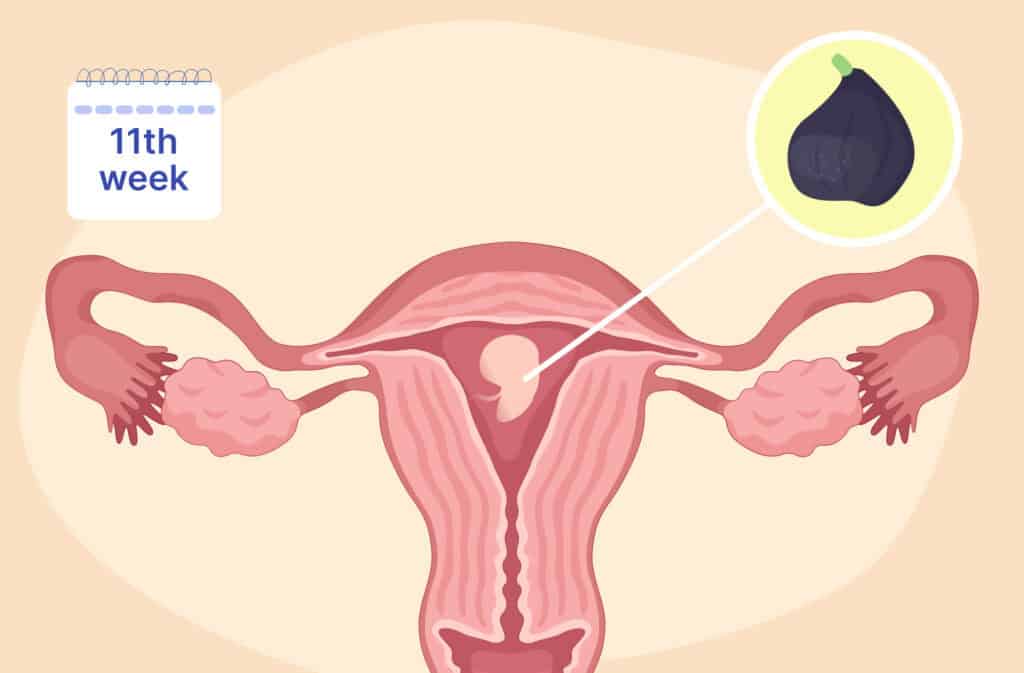Femia > Health Library > Being a mom > Newborn cues: Decoding your baby’s body language
Newborn cues: Decoding your baby’s body language

- Updated Feb 10, 2025
- Published
CRAFTED BY HUMAN
Crafted by human At Femia, we provide accurate and up-to-date information at every stage of your journey, from trying to conceive, pregnancy and postnatal support. All content is created by a real person based on in-depth research and own professional experience. Femia ensures that you will receive expert advice, strict accuracy and a personalized approach from our authors/medical experts. Learn more about our editorial policy.
FACT CHECKED
Fact checked At Femia Health, we maintain the highest standards of editorial excellence in delivering content focused on helping you conceive, guiding you through pregnancy, and supporting you postpartum. Explore our content review principles to learn how we ensure the accuracy and quality of our health and lifestyle tips for every stage of your journey.
- Signs a newborn is hungry include taking hands in the mouth, making sucking sounds, moving towards the chest or turning side to side, and crying. The signs a baby is full are slowing down or stopping feeding, spitting out, closing their mouth, turning their head away, or appearing satisfied and relaxed.
- Signs a baby is sleepy include yawning, losing interest in people or toys, staring at one place, closing eyes, or appearing inactive.
- The signs a baby may be uncomfortable or in pain include crying constantly, sleep or behavior changes, and refusal to feed for a prolonged time.
- The common tip to differentiate between the cues is to assess timing, like how long it’s been since your baby has fed or slept.
Newborn cues are an interesting language that conveys your baby’s needs through body language and sounds. However, cues can be stressful if you fail to understand what your baby is trying to convey. Understanding, differentiating, and responding to newborn cues are great ways to build a strong bond with your baby, enable better caregiving, and reduce stress.
Let’s discuss newborn cues in detail as well as how to understand and respond to them appropriately. Admittedly, it is a time-consuming process that can be tricky for new parents but, with observation and practice, you can gradually improve and get a hold of it.
Femia offers personalized insights and helps you stay in control
What are newborn cues?
Newborn cues are gestures or sounds your baby makes, through which they communicate their needs, like hunger, fullness, sleepiness, pain, discomfort, or others. It is simply the newborn body language.
The gestures can include body movements, sounds, facial expressions, crying, sucking their hands, and more.
👉Find out more: Shaken baby syndrome: Understanding the causes, symptoms, and prevention
Baby cues chart: A guide to understanding newborn body language
Here is a newborn cues chart indicating what each baby cue can mean:

Hunger cues: How to recognize when your baby is hungry
Let’s discuss baby hunger cues in detail and how to recognize and understand them.
Signs baby is hungry
The early newborn hunger cues include:
- Hand to mouth. One of the most common signs that your baby is hungry is that they take their hands or fists closer to their mouth.
- Moving towards the breast. Another sign that your baby is hungry is that they constantly try to move towards your chest or breast.
- Lip-smacking. When hungry, your baby may think they are about to feed, which can cause them to smack or lick their lips in preparation.
- Rooting. Babies commonly turn their heads side to side and move their bodies in search of breast or bottle feed.
- Mouth opening. Your baby will open their mouth wider than normal when hungry.
- Alertness. Babies are often more alert and keep their eyes wide open when hungry.
The late newborn hunger cues can include:
- Crying. This is the first sign of late-stage hunger, where your baby loses its temper after waiting.
- Face turns red. When your baby’s face turns red from crying, it’s often the late stage of hunger. This can occur because the body releases stress hormones when the baby is excessively distressed, which increases blood flow to the skin and makes it red.
- Irritability. Your baby may also become irritable and cranky after tolerating hunger for a long period.
- Fussiness. Fussiness is when your baby cries a lot and now becomes difficult to calm and feed.
- Fast breathing. Your baby may also breathe faster in the later stages of hunger due to the body’s stress response and increased metabolic rate.
Signs a baby is full: How to know when a newborn is full
So, how to know when a newborn is full? Let’s find out.
The signs newborn is full include:
- Your baby refuses to feed more or loses interest in feeding or sucking.
- They release their mouth from the breast or feeding bottle.
- They become calm or drowsy and start to fall asleep while feeding.
- They move their head away from the breast or bottle.
Newborn sleep cues vs hunger cues: How to tell the difference
So, how to tell the difference between newborn sleep cues vs hunger cues? The major tip to identify the difference between newborn sleep and hunger cues is to assess timing. Analyze how long it’s been since your baby has fed or slept to determine whether the cue is related to sleep or hunger.
Other signs to identify the difference between hunger and sleep cues include:
- If your baby is hungry and you try to feed them, they will rapidly start sucking your breast or bottle, or else they may move their head away after feeding for a few seconds or refuse to suck. This can indicate whether the cue was due to hunger or not.
- If your baby is hungry, they will make sucking sounds or take their hands in their mouths while crying.
- If your baby is sleepy, they may rub their eyes, yawn, and appear drowsy, tired, or inactive.
Signs baby is tired, not hungry
The signs baby is tired not hungry include:
- Your baby will avoid eye contact and stare at one place.
- They will refuse to latch on your breast or bottle.
- They will become quiet, inactive, or fussy.
- They will cry when another person tries to hold them.
- They will make jerky movements or show clumsiness.
Responding to newborn cues: Building trust and connection
Timely responses to newborn cues are a great way to build an emotional and physical connection with your baby.
Here are some tips to respond to your baby’s cues effectively:
- Take recommendations from your baby’s pediatrician on how frequently you should feed your baby. This way, you will get an idea of when hunger cues may appear. Feed promptly when you feel that your baby may be hungry, but avoid forceful feeding.
- Frequently check for your baby’s comfort, like diapers, body temperature, if they are sweating or feeling cold, or have any stomach issues. Immediately consult a doctor if you think your baby may be ill.
- Try soothing techniques to make your baby fall asleep, like massaging before sleep, rocking, or swaddling.
👉Find out more: Baby’s head shape: When to worry?
Common challenges in reading baby body language
Challenges and misinterpretations when reading the baby’s body language are natural and common, particularly for new parents.
Many times, you may fail to understand what your baby is trying to convey, or you may find them crying even after you did every possible thing to address all their needs. However, these challenges will become easier to address as your bond with your baby grows, and you will gradually begin to understand their cues.
The common challenges in reading your baby’s body language and how you should address them include:
1. Unfamiliarity of cues
You may be unfamiliar with your newborn’s cues, especially during the early days after birth, and it may take some time to understand them. It may be overwhelming, but the key is to take the time to observe, listen, understand, and consider the context of your baby’s cues. You can also keep a journal to record your responses to your baby’s cues and their outcomes.
2. Overwhelming number of cues
Another common challenge in reading your baby’s body language is that they can show several unexpected cues, like crying, different facial expressions, cooing, irritability, fussiness, or others, making it difficult to distinguish.
Cues can vary depending on the context, so it is essential to consider the environment and situation to distinguish the cue. For example, if they are crying after a while of feeding or haven’t burped, they may feel gassy or have stomach aches.
3. Individuality of cues
It is important to note that each baby is unique, and their cues may vary compared to other babies. Hence, try not to get overwhelmed or worried if your baby’s cues differ or do not match others. Every baby’s way of conveying their needs may be different, so it is crucial to take the time to observe your baby’s behavior and respond to them according to the situation or as needed.
Femia offers personalized insights and helps you stay in control
When to seek help
You should consult a pediatrician regarding your newborn’s cues if:
- Your baby seems excessively fussy, irritable, or cranky and is difficult to console even after you fed them or addressed other possible concerns.
- You are unable to understand your baby’s cues.
- The cues are inconsistent with feeding, sleeping, or discomfort patterns.
- Your baby seems ill or isn’t feeding or sleeping properly.
Questions from the Femia community
Can newborn cues change as my baby grows?
Yes! As your baby's body and brain develop, their cues change, and they begin to show clearer and more direct signs to convey their needs, which are easier to interpret and respond to.
How can I prevent misinterpreting my baby’s cues?
To prevent misinterpreting your baby's cues, you first need to take time and observe your baby's behavior for hunger, sleep, discomfort, and other signs. Moreover, you can also analyze the cues based on timing. For example, if your baby hasn't fed for a while, their cue may indicate hunger, or, if they have fed but not slept, they may be sleepy, and so on.
Do hunger cues mean my baby isn’t getting enough milk?
No, hunger cues don't necessarily mean your baby isn't getting enough milk. It is normal for newborns to get hungry frequently, not take their required feed, and not get full at once. However, if you are still concerned about your baby's diet or your milk supply, it is best to consult a pediatrician for individualized advice.
How soon should I respond to newborn cues?
It is best to respond to newborn cues as early as possible without any delay, because the behavior can become difficult to soothe if it reaches later stages. Responding to cues promptly is also beneficial in building a strong bond and trust with your baby.
Does the cry-it-out method harm my baby?
The cry-it-out method won't harm your baby if you perform it appropriately and in short durations. Moreover, you should always respond to your baby if they cry excessively or for a prolonged period, as ignoring it can affect your baby's emotional development. Always try to consult a pediatrician for guidance on sleep training methods.
The bottom line
Understanding newborn cues is a journey that develops with observation and practice. Hence, cues may be overwhelming or difficult to differentiate at first, but gradually, you will understand your newborn’s body language and learn how to respond.
Above all, healthcare professionals and pediatricians are available to provide support and guidance if you face challenges with your baby that are difficult to address.
Remember, promptly responding to your newborn’s hunger, sleep, and discomfort cues is essential to improve their well-being, strengthen your mother-baby bond, and build trust with them.
References
- Hodges, Eric A., et al. “Development of Feeding Cues During Infancy and Toddlerhood.” MCN the American Journal of Maternal/Child Nursing, vol. 41, no. 4, June 2016, pp. 244–51. https://doi.org/10.1097/nmc.0000000000000251.
- “Feeding Your Baby: The First Year.” Cleveland Clinic, 1 May 2024, my.clevelandclinic.org/health/articles/9693-feeding-your-baby-the-first-year.
- “Expert Tips to Help Baby Sleep Through the Night.” Mayo Clinic, www.mayoclinic.org/healthy-lifestyle/infant-and-toddler-health/in-depth/baby-sleep/art-20045014.
- “Understanding Your Baby – Wirral Community Health and Care NHS Foundation Trust.” Wirral Community Health and Care NHS Foundation Trust, 15 Mar. 2024, www.wchc.nhs.uk/children-young-people/parents-carers/new-parents/understanding-your-baby.

Discover the common causes of burning after sex, from friction to infections, and explore solutions for prevention and treatment. Learn when to seek medical advice.

Learn about common symptoms at 14 days past ovulation (14 DPO), the day your period may be due, and confirm pregnancy with a reliable test. Expert advice from Femia.

Learn what’s happening at 11 weeks pregnant, from baby’s growth to your changing body. Explore tips for managing symptoms and supporting fetal development.

